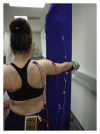Electromyographical comparison of four common shoulder exercises in unstable and stable shoulders
- PMID: 22919499
- PMCID: PMC3423969
- DOI: 10.1155/2012/783824
Electromyographical comparison of four common shoulder exercises in unstable and stable shoulders
Abstract
This study examines if electromyographic (EMG) amplitude differences exist between patients with shoulder instability and healthy controls performing scaption, prone horizontal abduction, prone external rotation, and push-up plus shoulder rehabilitation exercises. Thirty nine subjects were categorized by a single orthopedic surgeon as having multidirectional instability (n = 10), anterior instability (n = 9), generalized laxity (n = 10), or a healthy shoulder (n = 10). Indwelling and surface electrodes were utilized to measure EMG activity (reported as a % of maximum voluntary isometric contraction (MVIC)) in various shoulder muscles during 4 common shoulder exercises. The exercises studied effectively activated the primary musculature targeted in each exercise equally among all groups. The serratus anterior generated high activity (50-80% MVIC) during a push-up plus, while the infraspinatus and teres major generated moderate-to-high activity (30-80% MVIC) during both the prone horizontal and prone external rotation exercises. Scaption exercise generated moderate activity (20-50% MVIC) in both rotator cuff and scapular musculature. Clinicians should feel confident in prescribing these shoulder-strengthening exercises in patients with shoulder instability as the activation levels are comparable to previous findings regarding EMG amplitudes and should improve the dynamic stabilization capability of both rotator cuff and scapular muscles using exercises designed to address glenohumeral joint instability.
Figures
References
-
- Kuhn JE. A new classification system for shoulder instability. British Journal of Sports Medicine. 2010;44(5):341–346. - PubMed
-
- Neer CS. Involuntary inferior and multidirectional instability of the shoulder: etiology, recognition, and treatment. Instructional Course Lectures. 1985;34:232–238. - PubMed
-
- Rowe CR. Prognosis in dislocations of the shoulder. The Journal of Bone and Joint Surgery. American. 1956;38(5):957–977. - PubMed
-
- Burkhead WZ, Jr., Rockwood CA., Jr. Treatment of instability of the shoulder with an exercise program. The Journal of Bone and Joint Surgery. American. 1992;74(6):890–896. - PubMed
-
- Paxinos A, Walton J, Tzannes A, Callanan M, Hayes K, Murrell GAC. Advances in the management of traumatic anterior and atraumatic multidirectional shoulder instability. Sports Medicine. 2001;31(11):819–828. - PubMed
LinkOut - more resources
Full Text Sources



